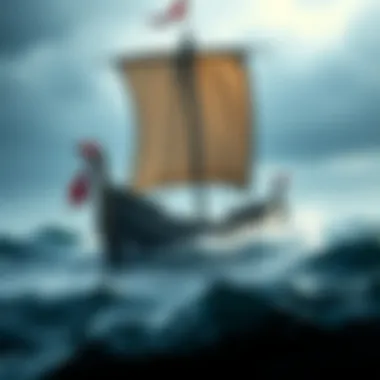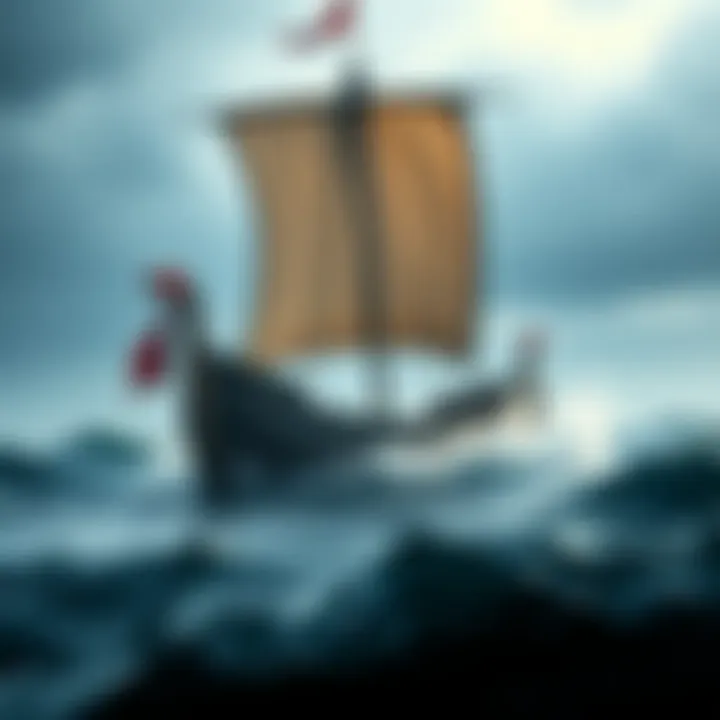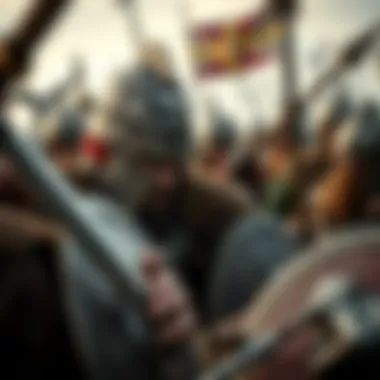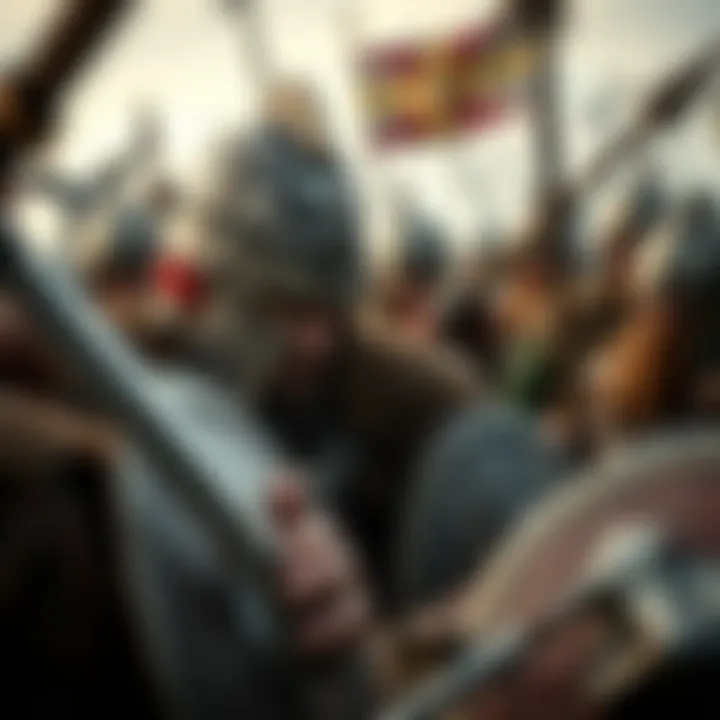Analyzing the Viking Saga of 16sfb: History and Impact


Intro
The Viking saga associated with the code 16sfb invites us to traverse a fascinating and often misunderstood historical terrain. Beyond just tales of adventure and conquest, these narratives encapsulate the societal norms, cultural expressions, and economic realities of an age where Norse explorers scoured unknown waters. It’s not merely about longships and raids; it’s the very fabric of how these histories have been woven into our contemporary understanding of the Viking legacy.
In this analysis, the crux of discussion hinges on pivotal aspects, including the historical significance of the saga, the intricacies of its narrative structure, and the lasting impact it exerts on modern interpretations of Viking culture. By delving deep into the socio-economic contexts of the Viking Age, one gains a more profound appreciation for how these sagas have echoed through time, shaping our views of Viking heritage even today.
As we unravel the layers of this saga, it’s critical to ask: how have historical interpretations been formed, and what implications do these narratives carry for our present understanding of Norse culture? The ensuing sections will strive to elucidate these inquiries, ensuring each element builds a cohesive understanding. Readers are poised to discover insights that illuminate the Viking legacy’s remarkable endurance and relevance in today’s societal frameworks.
Prelude to Viking Sagas
Viking sagas are more than mere tales of heroism and battles; they encapsulate rich historical narratives that reflect the complex interplay between culture, society, and values in the Viking Age. These narratives serve as a lens through which we can observe not just the Viking warriors but the entirety of the Norse world, including its beliefs, family dynamics, and even daily life. Understanding Viking sagas, especially in the context of the code 16sfb, allows readers to grasp the underlying themes and socio-economic frameworks that shaped the lives of these individuals.
Historical Background of Viking Literature
The roots of Viking literature can be traced back to the oral traditions that flourished long before written records emerged. These stories were often recounted around the hearth, where elders would pass down tales that depicted the exploits of gods, heroes, and even everyday folk. The preservation of these narratives in written form began in the 13th century, during a time when Norway and Iceland were experiencing significant political and cultural shifts. The sagas reflect a time when Scandinavia was redefining itself amid social upheaval, trade, and shifts in power dynamics.
The arrival of Christianity played a crucial role in this transition. With the introduction of the Latin alphabet came new storytelling methods, alongside a greater emphasis on historical authenticity. Scholars began recording sagas in a more structured format, blending history with folklore. A prime example is the Saga of the Ynglings, which connects Norwegian kings to the mythic past.
The Definition and Importance of Sagas
Sagas are essentially narratives that wrap history and fiction in a compelling package. They are not just stories; they carry the weight of historical events, social norms, moral dilemmas, and the importance of lineage. Each saga presents a mélange of fact and fiction, where the lines often blur, making it a complex yet fascinating genre. The study of these texts, particularly in relation to the code 16sfb, sheds light on why these stories have endured through the centuries.
The importance of sagas lies in their capacity to provide insight into the values and beliefs of Viking society. They reveal aspects of honor, loyalty, and revenge, as well as the roles played by both men and women in these often tumultuous times. By analyzing sagas, historians and literary scholars alike can uncover how these narratives molded perceptions of leadership, courage, and community in an era defined by exploration and conquest.
In summary, Viking sagas are pivotal for understanding the historical and cultural landscape of the Norse civilization. They bind together a rich tapestry of human experience, elucidating the nuances and intricacies of life during the Viking Age.
"The sagas are not merely stories; they are the echoes of civilization, reflecting the values and challenges faced by a people navigating their world."
Through this exploration, we can appreciate the sagas not just as artifacts of literary merit, but as vital conduits to understanding the intricacies of Viking heritage.
Deciphering 16sfb
Contextualizing the Code 16sfb
When hatchet meets stone, and the saga of yore intertwines with our understanding today, 16sfb emerges as more than just a numerical tag. It encapsulates a rich tapestry of Viking history, culture, and literature. To appreciate the depth of 16sfb, one must first grasp how this code weaves through various textual evidences that paint a vivid picture of Viking life.
At its core, 16sfb signifies a collection of sagas, possibly encoded or cataloged for academic scrutiny. The '16' in the code might imply a specific grouping or series, while 'sfb' might point to a particular thematic focus, perhaps spanning folklore, heroism, or maritime lore. The endeavor to decode this nomenclature isn’t just an exercise in intellectual curiosity; it’s a way of linking the past to the present, fostering a scholarly debate about authorship, chronology, and authenticity.
For those delving into Viking studies, the contextual factors at play with 16sfb might include linguistic diversity within Old Norse, geographic influences that shaped storytelling traditions, or the interactions between Vikings and neighboring cultures. This code serves as a reference point for understanding how narratives were preserved, transformed, and ultimately handed down through generations.
The Significance of the Code in Viking Studies
The 16sfb code has surmounted the confines of mere categorization; it occupies a pivotal role in contemporary Viking scholarship. One significant aspect of this code is its ability to catalyze discussion around the preservation and transmission of Viking narratives. Scholars find themselves grappling with questions surrounding authenticity—were these stories mere fabrications, or did they echo real-life encounters? Scholars parse through nuances within 16sfb, looking for insights that might bridge the gap between myth and historical fact.
Moreover, the 16sfb code becomes a focal point in discussing Viking identity. In a world increasingly keen on tracing ancestral roots, examining how these narratives have been borne and reborn sheds light on cultural resiliency.
Key Points of Significance:
- Understanding Cultural Legacy: The sagas tied to 16sfb illuminate the values and beliefs of Viking society, painting a picture that continues to resonate in modern times.
- Interdisciplinary Connections: The significance of the code extends into linguistic studies, archaeology, and cultural anthropology, enriching our understanding from multiple angles.
- Inspiring Modern Interpretations: Contemporary literature, gaming, and visual media often draw from these sagas, demonstrating the enduring impact of these narratives that form the crux of 16sfb.
The layers behind 16sfb offer a glimpse not just into a bygone era but into how those tales inform present and future narratives around Viking heritage.


In wrapping our minds around the 16sfb code, we unlock doors to a myriad of perspectives that connect Viking legacies to modern inquiries, whether one’s interest lies in the realms of academia or popular culture.
Narrative Structure of the Viking Saga
The narrative structure of the Viking saga serves as the backbone of these tales, shaping how history and myth intertwine within each story. It provides a framework that supports the unfolding of complex characters, vibrant settings, and pivotal conflicts. In this exploration, we shall focus on several key elements that enhance the understanding of Viking sagas and ultimately illuminate their importance in both historical and literary contexts.
Themes and Motifs in Viking Narratives
Viking sagas are rich tapestries woven with various themes and motifs. Heroism, fate, and the struggle between honor and vengeance often emerge as central drivers within these stories. Notably, the recurring motif of the journey illustrates not just the physical exploration of the Nordic landscape, but also the inner growth and moral dilemmas faced by characters.
For instance, in sagas like "Egil's Saga," we witness the protagonist's quest for honor leading him through violence and redemption, ultimately reflecting on the Viking ideals of bravery and loyalty. These themes are not merely for entertainment; they serve to pass down cultural values and provide moral guidance, even as they entertain.
Character Archetypes and Development
Character archetypes in Viking sagas often range from the noble warrior to the deceitful trickster. Each character, crafted with deep motivations and flaws, carries the narrative forward, creating a rich character ecosystem.
Take Ragnar Lothbrok, a recurring figure in Viking literature, who epitomizes the archetype of the hero driven by ambition and legacy. His boldness and complexity resonate with readers and symbolize the Viking spirit.
Moreover, the development of these characters is pivotal; they evolve with experiences, facing challenges that test their morals and beliefs. As the characters navigate their fates, the audience is invited to reflect on their decisions and the consequences that come as a result.
Chronological Order of Events
The chronological order within Viking sagas frequently plays a crucial role in the overall storytelling. While many sagas follow a linear progression, some employ flashbacks and time shifts, keeping the reader engaged and sometimes off-balance, compelling them to piece together the narrative puzzle.
In one saga, a climactic battle might be presented before the lead-up events, creating a tension that hooks the audience before they learn the motivations and stakes involved. This manipulation of time not only enhances the drama but also mirrors the chaotic nature of Viking life itself.
Cultural Context of the Saga
Understanding the cultural context of the Viking saga is essential to grasp how these narratives reflect the complexities of a society steeped in tradition and values. Situated within the seafaring culture of the Vikings, the sagas detail not only their heroic exploits but also the societal norms and values that shaped their everyday lives. By examining these aspects, we can appreciate how the Viking age was characterized by a mix of warfare, trade, and interactions with other cultures, which ultimately influenced their storytelling.
Viking Society and Its Values
Viking society, often viewed through the lens of fierce warriors and raiders, was much more nuanced. Their culture thrived on principles such as honor, loyalty, and bravery, which permeated their sagas. Each character's actions reflected a commitment to their community and family. Take, for instance, the importance of kinship; the sagas delve into family ties, where allegiance to one's clan often outweighed personal desires.
- Honor was paramount: A Viking's reputation could be enhanced by demonstrating courage in battle or cunning in commerce. Failure to uphold one’s honor could lead to severe social ostracism.
- Loyalty played a critical role, both within clans and among ship crews. Betrayal was one of the gravest sins imaginable and often precipitated dire consequences.
- Bravery was venerated, and sagas frequently recounted tales of feats that involved the daunting odds faced in battle or upon the high seas.
This cultural backdrop created a framework where each saga served not just as entertainment, but as a repository of values essential to the Viking ethos.
Influence of Religion and Mythology
Viking sagas are interwoven with elements of religion and mythology, offering insights into how these factors shaped societal beliefs and practices. The pantheon of Norse gods—Odin, Thor, Freyja, and Loki—provided a spiritual structure for Vikings that influenced their perceptions of fate and the supernatural.
Mythology was not just a backdrop but an active character in these sagas, guiding the Vikings' actions and decisions. For example, many heroes sought guidance from the Norns, who symbolized destiny, reminding characters that central tenets of fate were predetermined, yet still could be influenced by their actions. Thus, narratives highlight not just human endeavor but also a recognition of the divine orchestration in every decision.
- Rituals: Various rites and celebrations, such as blóts (sacrificial offerings), reflect the integration of faith in everyday life, thus illustrating how intertwined mythology was with societal progression.
- Moral Lessons: Many sagas contain moral undertones that draw from these myths, offering teachings about human nature and ethical conduct, which lend richness to our understanding of Viking values.
The Role of Women in the Narratives
While sagas are often dominated by male heroes, the role of women unveils a complex and diverse aspect of Viking culture. Women were not mere background figures; they were crucial players in various capacities, from warriors to peacekeepers.
In some narratives, we encounter strong female characters who defy norms, such as Lagertha, the legendary shield-maiden, whose fierce spirit is equally respected as any male warrior. Women could own land, engage in trade, and had a voice in family matters, which challenges stereotypical depictions often associated with past societies.


- Guardians of Heritage: Women also functioned as keepers of sagas, passing down stories orally through generations, ensuring that cultural memory and traditions were preserved.
- Influencers in Politics: The sagas often depict women as mediators or peacemakers; their marriages were oftentimes political alliances, providing a strategic advantage to clans.
Even though Viking society had its battles, the significance of women in the narratives indicates that they played foundational roles that shaped the cultural and social dynamics of their world.
"The Viking sagas reveal a tapestry of interconnected lives and beliefs, charting a course through their complex society, where honor, divine influence, and the unexpected roles of women crafted a rich cultural narrative."
By taking into account these specific elements of Viking culture, the sagas grow into something more than mere legends; they become living documents articulating the values, challenges, and intricacies of an extraordinary people.
Linguistic Analysis of the Saga
The study of the linguistic aspects of Viking sagas offers a windows into the heart of Norse culture. It reveals not just the words and structures used but also how the Old Norse language reflects the values, beliefs, and social dynamics of its time. Analyzing the language of these texts can ease us into an understanding of the era’s complex societal fabric, shaped by power, folklore, and survival. In this section, we will dissect the evolution of the Old Norse language and explore the artistic devices that give these sagas their distinct flavor.
Old Norse Language and Its Evolution
The Old Norse language, spoken from around the 9th to the 13th centuries, is the bedrock of our understanding of Viking literature. It's crucial to grasp its trajectories to fully appreciate the sagas. As the Vikings roamed and settled in various territories, this language morphed significantly. It was not static.
Notice how geographical spread influenced language. Words drifted, meanings morphed. Just as you might find variants in spoken language across different regions today, so too did Old Norse evolve. Key dialects emerged: Old West Norse was spoken in Norway, and Old East Norse thrived in Sweden and Denmark. The language consequently developed in regional clusters, leading to unique expressions and terms.
Benefits of Analyzing Old Norse
- Understanding Cultural Context: Language acts as a vessel carrying history. For instance, the words for social hierarchy reveal much about Viking society.
- Deciphering Mythological Elements: Terms used in sagas often allude to mythological stories or characters, offering insight into what shaped the Viking worldview.
- Tracing Heritage: Many modern Scandinavian languages evolved from Old Norse, and the etymological roots provide a clue to shared historical narratives.
Literary Techniques and Stylistic Features
Beyond vocabulary, the artistic techniques found in the sagas serve to enrich the text and engage the audience. These narratives used specific devices that elevated storytelling to an art form. Think of metaphors, alliteration, and kennings, which are compound expressions that convey layered meanings. An example from the sagas is “whale-road” to signify the sea—images that instantly evoke vivid imagery and emotional resonance.
Significant Techniques in Viking Sagas
- Alliteration: This technique echoes the sounds, captivating the audience. For instance, phrases like “brave Bjorn” would stick in minds, enhancing memorability.
- Repetition: Often used to reinforce key themes. It reflects the oral tradition, as reciters would repeat important lines for emphasis.
- Symbolism: Objects or characters often symbolize broader concepts. A sword might stand for honor, while a raven might symbolize death or fate.
“The echo of words spoken in the past still resonates today, reminding us that language has power beyond mere communication.”
Each turn of phrase weaves a richer tale yet, engaging readers of all backgrounds. By dissecting the linguistic layers in these sagas, we can appreciate the artistry of the ancient Norse storytellers while gaining deeper insights into their worldview.
The legacy of the Viking sagas, preserved through their language, persists as a powerful reminder of humanity's shared narratives.
Impact of the Viking Saga on Contemporary Culture
The Viking saga, particularly the narratives surrounding the code 16sfb, serves as a vital lens through which we can examine contemporary culture. These ancient tales, steeped in rich history and tradition, offer a myriad of reflections on modern values and interests. From their literary influences to their commercial exploitation, Viking sagas resonate with today’s society in fascinating ways.
Viking Influence in Modern Literature and Media
The ripples of Viking sagas can be seen across a spectrum of modern literature and media. Many authors draw inspiration from these age-old stories, often intertwining the valor and struggles of Viking heroes into contemporary plotlines. Novels such as The Last Kingdom by Bernard Cornwell breathe life into these characters while showcasing their complex moral landscapes. Moreover, the fantasy genre frequently weaves Viking imagery into its narratives, tapping into the appeal of raw adventure and conflict.
In film and television, productions like Vikings and The Northman demonstrate a stark resurgence of interest in Viking culture. These visual works don’t just tell these stories; they embed them in a rich tapestry of stunning cinematography and rugged landscapes, enticing viewers to develop a deeper connection to the Viking world. The portrayal of characters often reflects modern ideals of heroism, community, and individualism, all while being rooted in historical context.
Additionally, video games like Assassin’s Creed Valhalla allow players to explore the Viking Age interactively, blending entertainment with education. Gamers navigate a world populated by Norse gods, epic battles, and conquests, bringing the historical narrative directly to a new generation. The dialogues, quests, and lore found within these games often spark curiosity about the broader implications of Viking culture, driving the interest in further research.
The Rise of Viking Tourism
Viking sagas have fueled a wave of tourism, drawing millions to explore sites steeped in Norse mythology and history. Countries like Norway, Sweden, and Denmark showcase their Viking heritage through museums, reenactments, and guided tours. Locations such as the Viking Ship Museum in Oslo and the Lofotr Viking Museum in the Lofoten Islands present immersive experiences that breathe life into these ancient narratives.


The allure of Viking history isn’t just local; it has global appeal. Tourists from all corners of the world seek out destinations that promise adventure and connection to the past. The rise of Viking-themed festivals, with their lively displays of sword fighting and traditional crafts, captivate audiences and encourage participation, offering a glimpse into the Vikings’ daily life and values.
This burgeoning Viking tourism not only generates economic benefits but also promotes cultural exchange and education. Visitors walk away with a better understanding of the Viking legacy, and many return home inspired to learn even more about this fascinating segment of history.
“The sagas serve as both history and mythology, forming a bridge from past to present.”
In summary, the impact of Viking sagas on contemporary culture is both profound and enduring. Their influence permeates literature and media, capturing the imagination of modern audiences. Moreover, the rise of Viking tourism underscores a human yearning to explore the past, shaping a deeper appreciation for these narratives and the culture they represent.
Research and Scholarship on Viking Sagas
The investigation into Viking sagas is not merely an academic exercise; rather, it serves as a gateway to understanding a culture that profoundly influences many aspects of contemporary life. Research in this domain unveils a tapestry of narratives reflecting societal norms, values, and existential queries of the Viking age. Scholars dissect these tales to glean insights not only about the past but about how these ancient stories resonate with modern society. Thus, the importance of research and scholarship on Viking sagas lies in their capacity to contextualize our contemporary world against the backdrop of Viking history, revealing continuities and transformations in cultural identities.
Current Trends in Viking Studies
In recent years, Viking studies have been experiencing a renaissance of sorts. This resurgence has been marked by a growing interest in interdisciplinary approaches, merging archaeology, literary analysis, and social history. Researchers are increasingly exploring the role of Vikings in trade networks, migration, and cultural exchange, further illuminating their impact beyond the Scandinavian nexus. Popular among academia is the focus on digital humanities—using technology to analyze manuscripts and access previously untapped resources through digital media.
Some current trends include:
- The Application of Archaeological Findings: Ongoing excavations in regions like Denmark and Ireland reveal artifacts that directly connect to saga narratives, offering empirical support for the stories.
- Cross-Cultural Comparisons: Scholars now draw parallels between Viking sagas and other global epic traditions, creating a more comprehensive understanding of narrative structures.
- Reinterpretation of Women’s Roles: Recent studies are challenging traditional views by showcasing portrayals of women in sagas, emphasizing their agency and influence on the narratives.
Challenges in Viking Research
Despite the advances in Viking scholarship, there are significant hurdles that researchers face in this compelling field. One of the most pressing concerns is the fragmentary nature of the evidence. Many sagas were transmitted orally long before they were written down, leading to variations that make establishing a definitive narrative style complex. Likewise, the disparity in manuscripts calls for a careful and critical examination of sources.
Further challenges include:
- Language Barriers: The Old Norse language, with its numerous dialects and evolving nature, poses difficulties for scholars focused on accurate translations and interpretations.
- Resource Allocation: Funding for expansive archaeological projects is often limited, hindering the potential for discovery and research.
- Public Interest vs. Academic Rigor: The romanticized portrayal of Vikings in popular culture can distort scholarly work, making it harder to disseminate well-researched narratives while still reaching the general public.
Culmination
The exploration of Viking sagas remains a vibrant and essential avenue within the humanities. It allows for a nuanced understanding of a culture often pigeonholed within stereotypes. As research continues to evolve, the dialogue between history and modernity intensifies, proving that these sagas are just as relevant today as they were in the past. Scholars striving to navigate these waters contribute to a richer, more contextual narrative that challengers accepted norms and invites an appreciation of the legacy left by the Vikings.
Closure: Legacy of the Viking Saga
The legacy of the Viking saga is woven intricately into the fabric of both historical understanding and contemporary cultural expressions. These narratives, passed down through generations, have not only preserved the tales of fierce warriors and seafaring explorers but also reflect the values and existential questions of their time. They bespeak a society rich in tradition and deeply in tune with the natural world, while tackling universal themes such as honor, fate, and the complexity of human experience.
"The sagas serve as a mirror to understanding both the past and ourselves; they are not merely stories, they are the roots of cultural identity."
Continuing Relevance of Viking Narratives
The narratives encapsulated in the Viking sagas continue to resonate in today's world for several reasons. Firstly, they provide profound insights into the human condition; themes like heroism, loss, and community echo across time and culture. Take, for instance, the emphasis on kinship and loyalty found within these stories. Modern audiences can relate to these themes on a emotional level, making them as relevant today as they were a millennium ago.
Moreover, the Viking sagas offer a framework for comparing historical societal norms and behaviors with contemporary ethics. By examining the motivations and moral dilemmas faced by figures in these sagas, one can gain perspective on issues still prevalent in our societies, such as power dynamics and personal sacrifice.
Additionally, sagas have influenced various forms of media—from literature to film—thus keeping the Viking narrative alive in popular culture. Titles such as "The Last Kingdom" or the video game series "Assassin's Creed" extend the tales of the Vikings into new dimensions, ensuring that their relevance transcends time.
Future Directions in Viking Studies
The future of Viking studies appears promising, with scholars increasingly focusing on interdisciplinary approaches. While traditional historical research remains vital, there is a growing interest in integrating fields such as archaeology, anthropology, and even environmental studies into the examination of Viking culture and sagas. This holistic approach might yield richer insights into how those ancient societies functioned and how their legacies continue to influence modern culture.
Furthermore, advances in technology are opening new doors for exploration. Digital humanities tools, such as geographic information systems (GIS), allow researchers to map out Viking settlements and maritime routes more effectively than ever before. These advancements create opportunities to challenge existing theories and embrace new interpretations of Viking life as depicted in the sagas.
In essence, as the world continues to evolve, so too will our understanding of the Viking saga and its vast implications. Ongoing research, combined with a renewed interest in cultural heritage, secures the saga's place not just in historical discourse but in the ever-changing narrative of human civilization.
For those looking to further their exploration of the Viking saga, valuable resources can be found on sites like Wikipedia and Encyclopædia Britannica.
In the grand tapestry of human stories, the Viking saga offers threads that bind us to our past while illuminating the road ahead.



